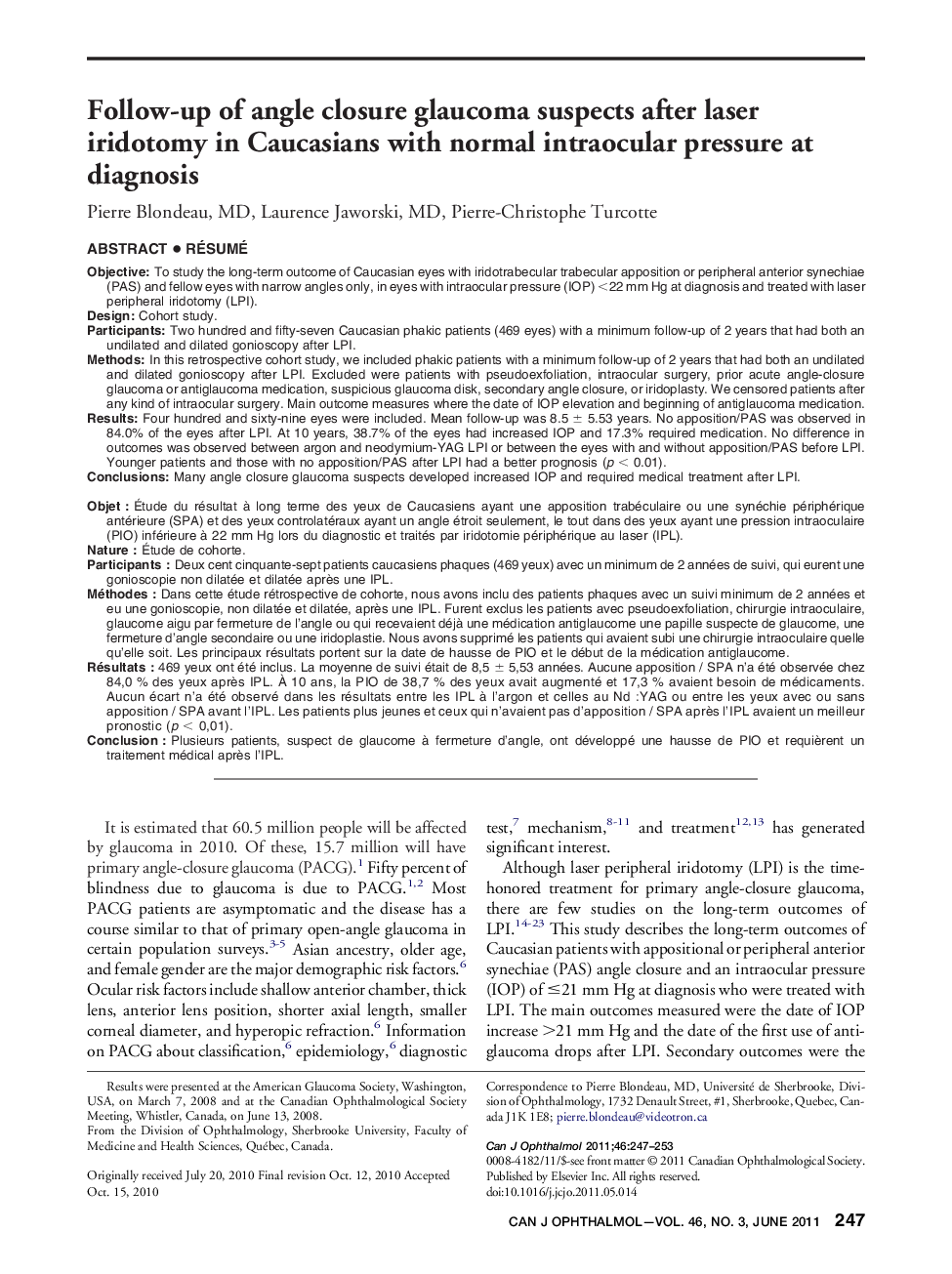| کد مقاله | کد نشریه | سال انتشار | مقاله انگلیسی | نسخه تمام متن |
|---|---|---|---|---|
| 4009819 | 1602423 | 2011 | 7 صفحه PDF | دانلود رایگان |

ObjectiveTo study the long-term outcome of Caucasian eyes with iridotrabecular trabecular apposition or peripheral anterior synechiae (PAS) and fellow eyes with narrow angles only, in eyes with intraocular pressure (IOP) <22 mm Hg at diagnosis and treated with laser peripheral iridotomy (LPI).DesignCohort study.ParticipantsTwo hundred and fifty-seven Caucasian phakic patients (469 eyes) with a minimum follow-up of 2 years that had both an undilated and dilated gonioscopy after LPI.MethodsIn this retrospective cohort study, we included phakic patients with a minimum follow-up of 2 years that had both an undilated and dilated gonioscopy after LPI. Excluded were patients with pseudoexfoliation, intraocular surgery, prior acute angle-closure glaucoma or antiglaucoma medication, suspicious glaucoma disk, secondary angle closure, or iridoplasty. We censored patients after any kind of intraocular surgery. Main outcome measures where the date of IOP elevation and beginning of antiglaucoma medication.ResultsFour hundred and sixty-nine eyes were included. Mean follow-up was 8.5 ± 5.53 years. No apposition/PAS was observed in 84.0% of the eyes after LPI. At 10 years, 38.7% of the eyes had increased IOP and 17.3% required medication. No difference in outcomes was observed between argon and neodymium-YAG LPI or between the eyes with and without apposition/PAS before LPI. Younger patients and those with no apposition/PAS after LPI had a better prognosis (p < 0.01).ConclusionsMany angle closure glaucoma suspects developed increased IOP and required medical treatment after LPI.
RésuméObjetÉtude du résultat à long terme des yeux de Caucasiens ayant une apposition trabéculaire ou une synéchie périphérique antérieure (SPA) et des yeux controlatéraux ayant un angle étroit seulement, le tout dans des yeux ayant une pression intraoculaire (PIO) inférieure à 22 mm Hg lors du diagnostic et traités par iridotomie périphérique au laser (IPL).NatureÉtude de cohorte.ParticipantsDeux cent cinquante-sept patients caucasiens phaques (469 yeux) avec un minimum de 2 années de suivi, qui eurent une gonioscopie non dilatée et dilatée après une IPL.MéthodesDans cette étude rétrospective de cohorte, nous avons inclu des patients phaques avec un suivi minimum de 2 années et eu une gonioscopie, non dilatée et dilatée, après une IPL. Furent exclus les patients avec pseudoexfoliation, chirurgie intraoculaire, glaucome aigu par fermeture de l'angle ou qui recevaient déjà une médication antiglaucome une papille suspecte de glaucome, une fermeture d'angle secondaire ou une iridoplastie. Nous avons supprimé les patients qui avaient subi une chirurgie intraoculaire quelle qu'elle soit. Les principaux résultats portent sur la date de hausse de PIO et le début de la médication antiglaucome.Résultats469 yeux ont été inclus. La moyenne de suivi était de 8,5 ± 5,53 années. Aucune apposition / SPA n'a été observée chez 84,0 % des yeux après IPL. À 10 ans, la PIO de 38,7 % des yeux avait augmenté et 17,3 % avaient besoin de médicaments. Aucun écart n'a été observé dans les résultats entre les IPL à l'argon et celles au Nd :YAG ou entre les yeux avec ou sans apposition / SPA avant l'IPL. Les patients plus jeunes et ceux qui n'avaient pas d'apposition / SPA après l'IPL avaient un meilleur pronostic (p < 0,01).ConclusionPlusieurs patients, suspect de glaucome à fermeture d'angle, ont développé une hausse de PIO et requièrent un traitement médical après l'IPL.
Journal: Canadian Journal of Ophthalmology / Journal Canadien d'Ophtalmologie - Volume 46, Issue 3, June 2011, Pages 247–253